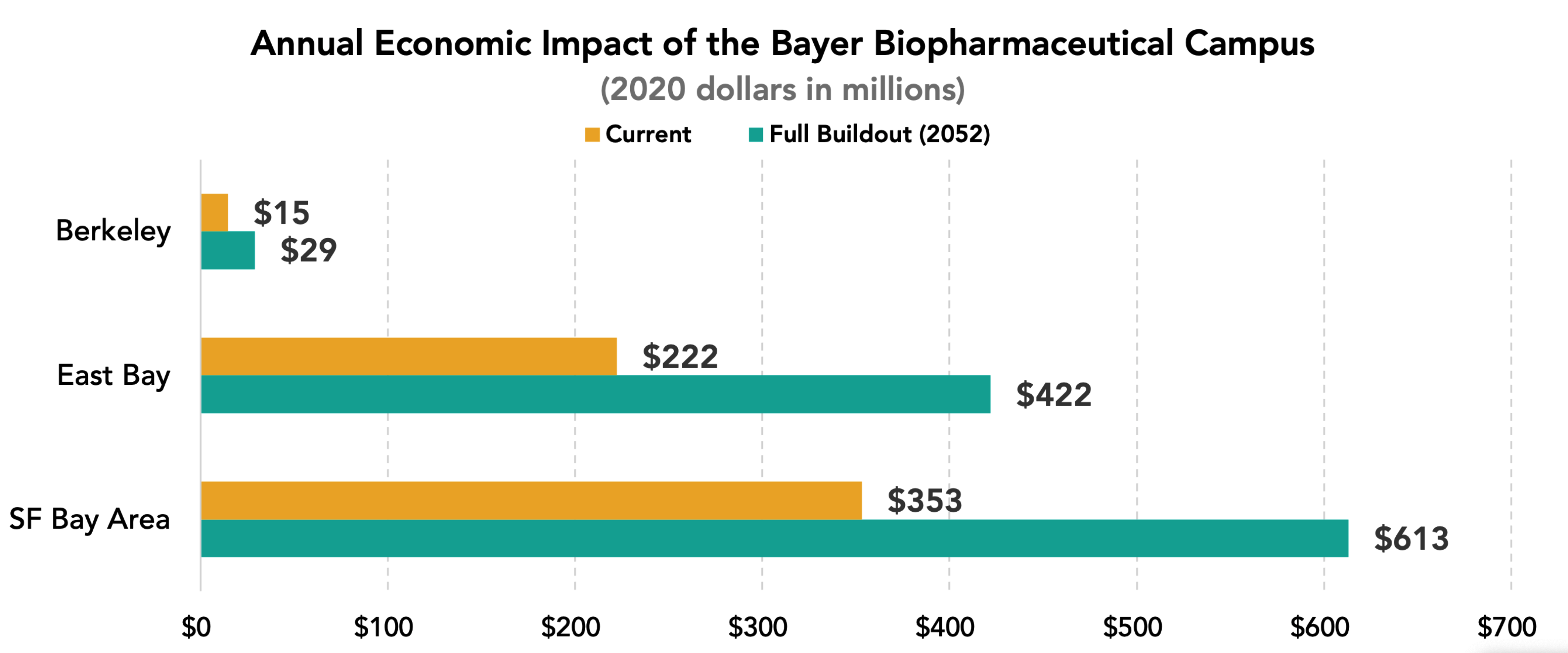Bayer’s economic impact on the City of Berkeley, the East Bay (Alameda and Contra Costa counties combined), and the nine-county San Francisco Bay Area is analyzed using Bayer data on employment and wages, contingent labor force, supplier and vendor spending, and capital expenditures. All data presented herein represents an annual impact. Data points were collected from 2019 and 2020, when available. Numbers are averaged when both years of data were used.
Looking out to 2052 (when Bayer assumes full buildout of its new campus), Bayer’s economic impacts would benefit from an increased employee headcount and the construction required to expand its campus. By 2052, Bayer projects 2,000 employees total at the Berkeley campus (a 2x increase from current levels), while 900,000 square feet of new facility construction and potentially 779,500 square feet in parking structure construction would take place over 30 years under an extended development agreement.
City of Berkeley Impacts
Home to Bayer’s biopharmaceutical center, Berkeley benefits directly from the presence of Bayer, which is the city’s largest private sector business employer. Economic impacts for Berkeley include:
• The campus employed an annual average of 1,024 people over 2019 and 2020, with an average of 56 employees residing in Berkeley.
• Multiplier effects (e.g., employee spending, supplier and vendor expenditures) support an additional 51 full-time equivalent jobs in Berkeley. For every 10 Bayer employees that reside in Berkeley, an additional nine jobs are supported within the city.
• Bayer’s direct spending in Berkeley totals $8.0 million annually. These dollars include employee and contingent labor wages paid to Berkeley residents, and expenses for suppliers and vendors and capital expenditures at a Berkeley-based company.
• When including the value of every transaction stemming from an original Bayer expenditure, Bayer creates an annual economic impact of $14.8 million in Berkeley.
• Projecting to 2052: Bayer’s expansion will support 204 jobs annually in the City of Berkeley, compared to 107 jobs currently.
• Projecting to 2052: Bayer will have a $29.1 million annual economic impact on Berkeley by 2052 (in 2020 dollars), an increase of 96.8% over the current annual impact.
East Bay Impacts
While Bayer’s biopharmaceutical campus is based in Alameda County, Contra Costa County also serves as an important part of the labor shed, and both counties capture significant benefits from Bayer’s presence. Economic impacts to the East Bay include:
• On average over the two-year period from 2019 to 2020, 715 of Bayer’s 1,024 employees lived within the East Bay (69.8% of the total).
• When including multiplier effects and Bayer’s other spending categories, Bayer currently supports a total of 1,547 jobs in the East Bay. For every 10 Bayer employees that are East Bay residents, another 12 jobs are supported across Alameda and Contra Costa counties.
• Bayer spends $110.0 million annually on direct expenditures into the East Bay, including wages, suppliers and vendors, and capital expenditures.
• When including multiplier effects and the direct expenditures, Bayer creates $222.5 million in annual economic impacts for the East Bay.
• Projecting to 2052: Bayer’s expansion will support 2,811 jobs annually in the East Bay, compared to 1,547 jobs currently.
• Projecting to 2052: In 2020 dollars, Bayer will have a $422.0 million annual economic impact on the East Bay by 2052, an increase of 87.7% over the current annual impact.
San Francisco Bay Area Impacts
Bayer is a key contributor to the region’s cluster of growing life sciences companies, and its impacts reach broadly across the Bay Area. Regional impacts include:
• Bayer’s presence supports 2,221 full-time equivalent jobs across the nine counties when including Bayer’s own employment, the impacts of spent wages, and the company’s regional expenditures. For every 10 Bayer workers employed by the Berkeley campus, another 12 jobs are supported across the Bay Area.
• Bayer spends $180.7 million annually within the nine-county region. Two-thirds of this spending is tied directly to wages.
• Overall Bay Area economic impacts related to Bayer’s presence in Berkeley total $353.2 million annually when accounting for all transactions linked back to the original Bayer expenditures.
• Projecting to 2052: Construction over 30 years will support 1,698 full-time equivalent job-years.
• Projecting to 2052: Bayer’s expansion will support 3,816 jobs annually in the Bay Area, compared to 2,221 jobs supported currently.
• Projecting to 2052: In 2020 dollars, Bayer will have a $613.1 million annual economic impact on the Bay Area by 2052, an increase of 73.6% over the current annual impact.

